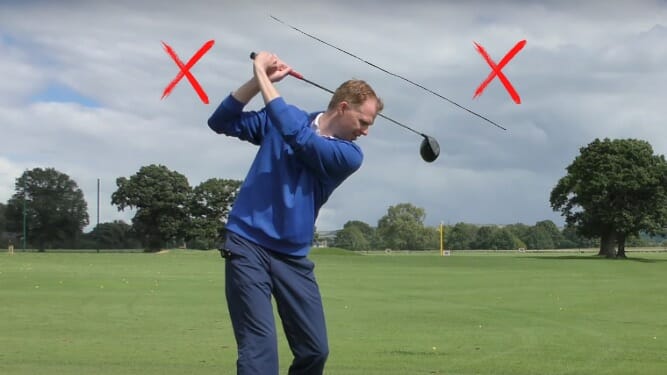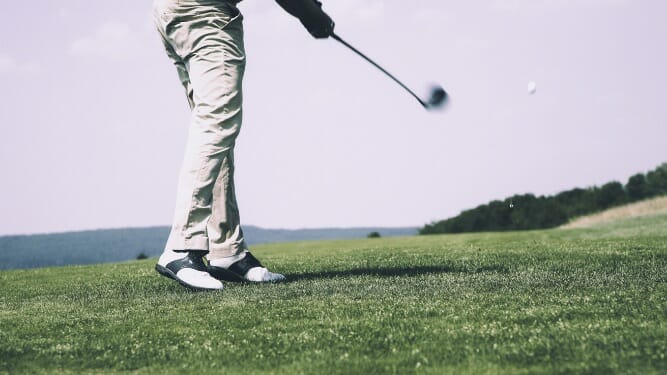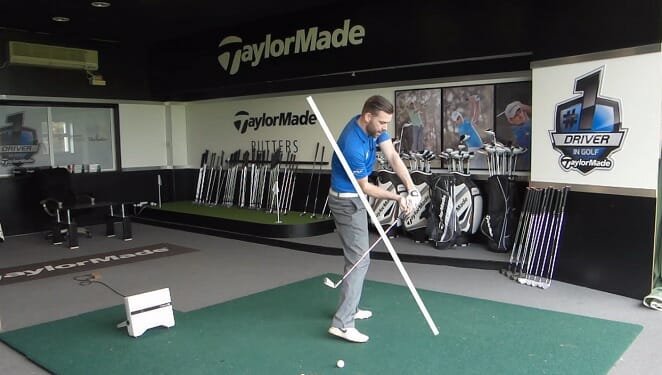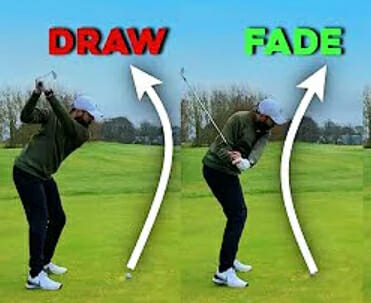I have frequently seen double-crosses in my years of playing golf but when I mention them most beginner golfers don’t know what the phrase means.
I suggest that you continue reading as I share my expertise on what a double-cross is in golf and how to avoid it. Thus, at the end of this post, you should be able to completely focus on playing the course and managing your game:
What is the Definition of a Double Cross?
When you are aiming for a draw or fade(curveball) and end up hitting it in the opposite direction of your aim, it’s known as a double-cross. The disadvantage of this shot is that you will almost certainly wind up considerably off of the target line, resulting in a bogey or worse shot.

What is an Example of a Double Cross?
Consider the case of a golfer who wishes to hit a fade. One of the most straightforward techniques to hit a fade is to angle your body slightly left and maintain the clubface slightly open at impact. It would be best to maintain the clubface open for a second longer, and your ball will fly with a lovely fade.
The difficulty is that when they approach the golf ball, some players become apprehensive. Suddenly, the thought of a slice occurs to them, and instead of trusting the fade ball flight laws, they rapidly flip their wrists and hit a huge hook.
To avoid the right side of the course, the golfer will angle the clubface down and drag the ball directly to the left. This is a double-cross because the golfer deviated from their initial plan.
A double-cross is a troublesome problem since the miss it causes is frequently twice as awful as the well-planned first shot. Due to their slicing, golfers who aim far left of a target occasionally do not slice the ball. If a golfer strikes a hook while aiming left, their golf shot will certainly travel out of bounds.
What Causes a Double Cross in Golf?

The more you improve at golf, the further you realize how important your mental game is to your entire performance. (1)
The mental game is the main reason for the double-cross. Players begin to question their positioning and alignment. When players have these uncertainties, they begin to make minor adjustments to their swing as they approach the golf ball.
When you shoot down one side intending to curve the shot back toward the target, but it curves the opposite direction, it’s known as a double-cross. This is due to an improper alignment of your clubface and swing path.
When it comes to avoiding the double-cross, trusting yourself is one of the best things you can do. Of course, you won’t have the complete confidence to do this if you don’t practice your shot regularly. You will have considerably more success in your golf game if you believe and train yourself.
Once you’ve determined a shot, stick with it and trust it until you accomplish it. Adjusting things as you get closer to the impact position would only lead to a double-cross and further problems. Another issue that many golfers face is that they tend to overcorrect.
What Happens If You Overcorrect?

We call an overcorrected shot when a player tries to prepare for a bad shot or a miss in golf, but they end up getting themselves into greater trouble.
Consider a golfer who frequently slices the ball. If you are a player like this, you already know that aiming down the left side of the golf course will help you avoid getting into more difficulties with your slice.
According to a theory, shooting down the left side of the fairway will cause the ball to spin slightly right and land on the right side of the fairway or in the right rough. Many golfers approach every round in this manner. You may also perform this to improve misses and since, for the most part, you will not be able to correct a lifelong slice while on the golf course.
The issue is that many players are taking this slice of scheming to a new level. They try to help themselves by aiming down the left side, but it hurts them.
So, what does actually happens if you aim left on a hole with difficulty to the left and hit the golf ball straight?
Well, punishing yourself for striking the ball straight is never a good idea. The majority of golf pros and excellent players will advise you that you need to work on your slicing. While we recognize that this is not feasible for all golfers, we strongly recommend that you at least double-check that you are not putting yourself in danger.
You may aim towards the middle of the fairway on a hole with trouble all the way down the left side. Even if you finish up in the right rough, you’ll still be able to make a nice hole.
If you are a player who only slices the ball once in a while, try aiming down the middle more regularly. Begin to believe in your own abilities to hit the ball straight. To start pulling off incredible golf shots, sometimes all it takes is a positive mindset and proper alignment.
The worst thing you can address is to set yourself up to avoid difficulty and then find yourself right in the middle of it. Bide your time, pay close attention to alignment and aim, and ensure you strike the target.
Tips to Avoid a Double Cross in Golf
Aside from ensuring that you trust yourself, there are other methods for avoiding a double-cross.
We have some tips below on how to prevent double cross golf:
Keep a Steady Wrist Angles

You’ll want to make sure your wrist angles are the same as they would be in a typical shot. When we’re worried about the outcome of a shot, our hands and wrists take over. They’ll try to correct the swing by working against the larger muscles.
Overall, this is a risky action, and your hands and wrists should never work separately from the rest of your golf swing.
It would be perfectly acceptable if your last swing thinking before hitting your shot is to make sure you preserve your wrist angle. You can also move the ball somewhat further back in your stance to prevent the double-cross while hitting a fade. This extra distance back can sometimes give the golfer less time to close the clubface and double-cross. (2)
You should not go too far back in your stance with this ball location since it could cause other problems. Again, if you are going to start hitting fades and draws and experimenting with ball flight laws, you’ll need to spend more time working on these skills at the range.
If you find yourself double-crossing every time you attempt one of these strokes, it’s best to stick with hitting the ball straight for the time being.
Consistent Club Route

Furthermore, creating a consistent club route and interaction with the club’s face may also help you. To hit a push draw, you’ll need a clubface that’s 1-3 degrees open to the target line, with a path that’s 2-4 degrees right of it. This will lead to a shot that starts to the right of the target and circles back to it.
If your route is only 2-4 degrees right of the goal line, a 5-degree open clubface will begin immediately and fade right if your path is only 5 degrees right of the target line. To fade, hit at 13 degrees to the target line and at a direction of 24 degrees to the left.
This will result in a shot that curves back to the target from the left. There is a fine line here, and if your clubface is too far to the left, it will start and curve to the left. There are some terrific workouts and strategies to improve your stock shot so you can count on a consistent draw or fade.
Which is Better: Hitting a Draw and a Fade or Hitting the Ball Straight?

You may apply several theories to this subject, and most of the responses will depend on your existing golf handicap. Lower handicap players must learn how to hit the ball both left and right.
The reason for this is that if you can just hit the ball straight, you won’t be able to get close to the hole. There are times when pin positions require a shot to be faded or pulled into the pin. If you aren’t capable of making these types of shots, your overall score will most likely remain higher.
Attempting on the fade and draw-type shots may be too much for higher handicap players who can hardly hit the golf ball straight. One thing to consider is that if a higher handicapper can shoot a draw or fade, they should be able to hit the ball as well.
We pay so much attention to hitting the ball straight as golfers that we sometimes forget to play to our abilities. You should play a five-yard fade if your conventional golf swing produces one. This fade can be played all the way around the golf course while maintaining a low score.
The idea is to find something that you can do over and over again. You will receive a relatively high score if you lack consistency. It’s not the five-yard fade that’s hurting you.
When you hit a five-yard fade followed by a ten-yard pull followed by a snap hook, you are in trouble. Make an effort to improve your consistency in your golf game. You may work on hitting a fade or a draw-on order if you can do this.
Wrapping Up
Presumably, you now know what a double-cross is and how to prevent them in the future.
When it comes to golf shots, try to believe in yourself. Although you may not always succeed, if you commit to a shot and trust it, you will have a lot better chance.
When you try to remedy things with your wrists as you come through the golf ball, you are likely to wind up with the result that leads to a worse issue. You may follow the tips I stated above to avoid making double cross golf. The double-cross is a huge blunder, but you may avoid it.
You may want to check below product and learning guides. Until our next article!
References:
(1) mental game – https://medium.com/the-ascent/6-must-read-books-for-improving-your-mental-game-6e9f3b44067f
(2) wrist – https://www.healthline.com/health/wrist-bones

No responses yet